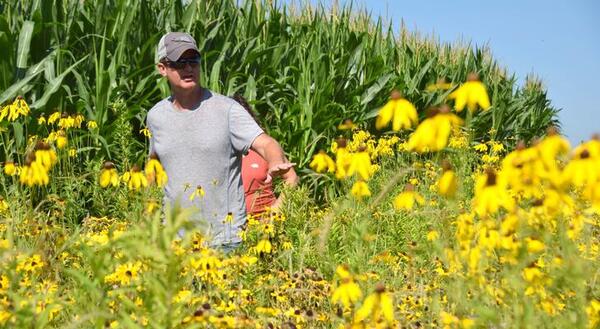
Almost everywhere you look on Brent Fowler’s farm, a restored habitat is visible. But it hasn’t always been that way.
Fowler grew up during the era of farm modernization when agriculture expanded in nearly every way. Fields got larger. Machinery got bigger. The crops shifted to more profitable grains and clean farming practices that reduced weedy vegetation in agricultural fields.
As farming changed, so did the landscape. Fencerows and hedgerows were removed. Small grains like oats and wheat were replaced by corn and soybeans. Much of the grazing land was converted to cropland. In the transition, habitat started to disappear.
“I’ve personally taken out miles and miles of fencing to make farming more efficient for bigger fields and bigger machinery,” admitted Fowler.
By every measure, Fowler was a successful McDonough County farmer. Yet, he was noticing fewer and fewer northern bobwhite quail. Once an abundant grassland game bird in the region, quail were becoming increasingly more difficult to find.
“There was about a five-year period when I did not see or hear any quail,” Fowler explained.
Fowler’s concerns were corroborated by research. According to studies conducted by the North American Breeding Bird Survey, a large-scale bird monitoring program, observations of northern bobwhite quail in Illinois declined dramatically over a fifty-year period. In surveys conducted on targeted tracts throughout the state, observers counted an average of 43.96 quail per survey route in 1970. In 2021, they would see only an average of 4.22 quail on those same routes. That’s nearly a 90 percent decrease in bobwhite observed during that fifty-year stretch.
Concerned by their flagging numbers, Fowler recognized that he needed to learn more – and do more – to help restore the quail population on his farm. So he started reading about conservation practices and visiting people who were experimenting with them on their own farms.
Fowler also learned that there were government initiatives, such as the federal Conservation Reserve Program, that could help with habitat restoration. In exchange for a yearly payment, farmers enrolled in such programs could voluntarily take land out of production and plant permanent cover that would improve the environment.
Closer to home, Fowler noticed the wildlife-friendly landscape his wife, Carrie, was cultivating on their own property. By reducing the amount of lawn and replacing it with native plants and trees, Carrie was creating a yard that was increasingly attracting more animals, birds and pollinators.
For Fowler, the answer was now clear. If he wanted to help the quail, he would have to re-establish their habitat.
The Farm’s Transition Begins
As a first step, he decided to reduce mowing, especially during the quails’ nesting season. Ditches and field margins, once neatly manicured, were allowed to revert to native grasses and forbs. These modifications created more cover for the quail and offered bobwhite chicks a better place to forage for insects.
Meanwhile, the winters moderated for two consecutive years providing the quail a temporary reprieve from the bitter cold. With the weather now in their favor, and their habitat starting to improve, it wasn’t long until the quail started to come back.
Encouraged by his success, Fowler looked for more places where he could create quail habitat. He found them on the edges of his fields where the landscape transitions from crop to forest.
On these unproductive margins, the land was dominated by dense grasses and invasive shrubs; unsuitable conditions for quail. So Fowler turned these areas into prairies that he now routinely disturbs with cyclical burning and disking to invigorate their growth.
These prairies – 30 small fields on 160 acres – are now providing the quail with high quality food in a place they can easily navigate.
“More prairie equals more insects equals more quail,” Fowler explained.
Along the way there have been skeptics, including a handful of older farmers whose friendly kidding about Fowler’s reduced mowing practices has had its effect. Fowler has wondered: do “messy” field edges suggest he no longer takes pride in his property, or worse, that he isn’t a good farmer? And will these perceptions discourage future landowners looking for a tenant to rent their ground?
But Fowler is not easily discouraged. In fact, more than one of his landlords has expressed appreciation for Brent’s efforts to help protect habitat for wildlife.
The Rewards
Last fall Fowler enjoyed a moment that confirmed he was on the right track. While he was harvesting soybeans along one of his prairies, a covey of quail flushed ahead of the combine. It happened again the next day.
“This is hands down the best part of farming,” he remarked.
Fowler has noticed that his new habitats are also attracting other wildlife. Bobcats, eastern whip-poor-wills, bald eagles, rabbits, and a variety of pollinators are all visiting with some regularity. He has been especially gratified by the presence of short-eared owls, a state-endangered bird, now foraging along one of his restored grasslands.
“My favorite nature activity is walking through prairie and looking at all the bees and butterflies and knowing they are there because of me,” said Fowler. “Or running the combine and seeing a covey of quail fly out of the crop.”
Quoting from a popular 1980s movie, Fowler characterized his habitat restoration efforts this way.
“It sounds really corny to say, but ‘if you build it, they will come.’”
Inquiries
Brent Fowler welcomes inquiries from those who are curious about how they can start conservation initiatives on their own land. And while his efforts are conducted on a large scale, he reminds visitors that anyone with a yard can make a difference for wildlife. Contact him at fowlerfamily@mtcnow.net.
You can also learn more about creating wildlife habitat by contacting the IDNR District Wildlife Biologist in your area.
ADDITIONAL CREDITS:
This story originally appeared in Outdoor Illinois Journal, May 1, 2024